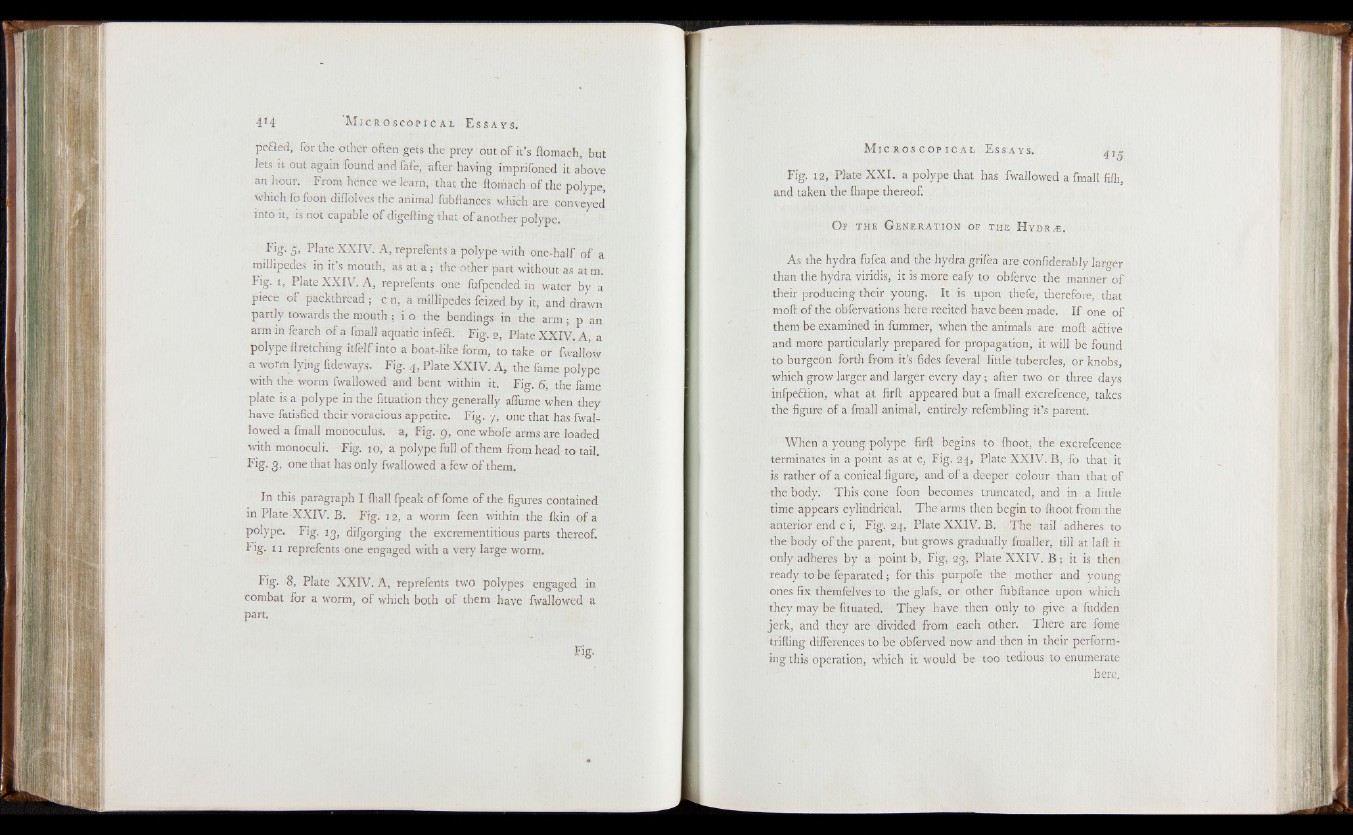
pefted, for the othel- often gets the prey out o f it’s ftomach, but
bets it out again found and fafe, after having imprifoned it above
an hour. From hence we learn, that the ftomach o f the polype,
which fofoon diflolves the animal fubftances which are conveyed'
into it, is not capable o f digefting that o f another polype.
Fig. 5, Plate XXIV. A, reprefents a polype with one-half o f a
millipedes in it’s mouth, as at a ; the other part without as at m.
Fig. t, Plate XXIV. A, reprefents one fufpended in water by a
piece of packthread ; c n, a millipedes feized by it, and drawn
partly towards the mouth; i o the bendings in the arm ; p an
arm in fearch o f a fmall aquatic in feci. Fig. 2, Plate XXIV. A, a
polype ftretching itfelf into a boat-like form, to take or fwallow
a worm lying lideways. Fig. 4, Plate XXIV. A, the fame polype
with the worm fwallowed and bent within it. Fig. 6, the fame
plate is a polype in the fituation they generally aflume when they
have fatisfied their voracious appetite. Fig. 7, one that has fwallowed
a fmall monoculus. a, Fig. 9, one whofe arms are loaded
with monoculi. Fig. 10, a polype full o f them from head to tail.
Fig- 3, one that has only fwallowed a few o f them.
In this paragraph I lhall fpeak o f fome of the figures contained
m Plate-XXIV. B. Fig. 12, a worm feen within the fkin o f a
polype. Fig. tg, difgorging the excrementitious parts thereof.
Fig. 11 reprefents one engaged with a very large worm.
Fig. 8, Plate XXIV. A, reprefents two polypes engaged in
combat for a worm, of which both of them have fwallowed a
part.
Fig. 12, Plate XX I. a polype that has fwallowed a fmall filh,
and taken the Ihape thereof.
O f the G eneration of the Hyd r^.
As the hydra fufca and the hydra grifea are eonfiderably larger
than the hydra viridis, it is more eafy to obferve the manner of
their producing their young. It is upon thefe, therefore, that
moil o f the obfervations here recited have been made. If one of
them be examined in fummer, when the animals are moft afiive
and more particularly prepared for propagation, it will be found
to burgeon forth from it’s lides feveral little tubercles, or knobs,
which grow larger and larger every day; after two or three days
infpeftion, what at firft appeared but a fmall excrefcence, takes
the figure of a fmall animal, entirely refembling it’s parent.
When a young polype firft begins to {hoot, the excrefcence
terminates in a point as at e, Fig. 24, Plate XXIV. B, fo that it
is rather o f a conical figure, and of a deeper colour than that of
the body. This cone foon becomes truncated, and in a little
time appears cylindrical. The arms then begin to {hoot from the
anterior end c i, Fig. 24, Plate XXIV. B. The tail adheres to
the body of the parent, but grows gradually fmaller, till at laft it
only adheres by a point b, Fig, 23, Plate XXIV. B ; it is then
ready to be feparated ; for this purpofe~ the mother and young
ones fix themfelves to the glafs, or other fubftance upon which
they may be fituated. They have then only to give a fudden
jerk, and they are divided from each other. There are fome
trifling differences to be obferved now and then in their performing
this operation, which it would be too tedious to enumerate
here.